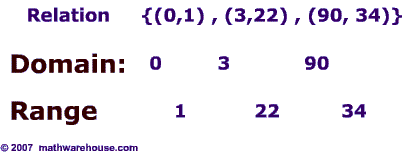"kelaskita.com"
- Some Examples of Relations include
- { (0,1) , (55,22), (3,-50) }
- { (0, 1) , (5, 2), (-3, 9) }
- { (-1,7) , (1, 7), (33, 7), (32, 7) }
A relation is just a set of ordered pairs. There is absolutely nothing special at all about the numbers that are in a relation. In other words, any bunch of numbers is a relation so long as these numbers come in pairs.
The domain and range of a relation
The domain is the set of all the first numbers of the ordered pairs . In other words, the domain is all of the x-values.
The range is the set of the second numbers in each pair, or the y-values.
The range is the set of the second numbers in each pair, or the y-values.
Examples of the Domain and Range
Examples of the domain and range of a relation.

In the relation above the domain is { 0, 3, 90 }
And the range is { 1, 22, 34 }

In the relation above the domain is { 0, 3, 90 }
And the range is { 1, 22, 34 }
Example two of the domain and range of a relation

In the relation above,

In the relation above,
- the domain is { 2, 4, 11, -21} the range is { -5, 31, -11, 3}
Practice Identifying Domain and Range
What is the domain and range of the following relation?
{ (-1,2), (2, 51), (1, 3), (8, 22), (9, 51) }
{ (-1,2), (2, 51), (1, 3), (8, 22), (9, 51) }
| Answer |
Domain: -1, 2, 1, 8, 9
Range: 2, 51, 3, 22, 51
What is the domain and range of the following relationRange: 2, 51, 3, 22, 51
{ (-5,6), (21, -51), (11, 93), (81, 202), (19, 51) }
| Answer |
Range: 6, -51, 93, 202, 51
| Answer |
Interactive Relation
As the ball drops, you can see the relation of the ball's position and time.
The general formula to express this relation is
f(time)= positionTry changing the speed of ball's position. How does the speed effect the relation.
What makes a relation a function in Math?
Functions
are a special kind of relation .At first glance, a function looks just like a relation. It's a set of ordered pairs such as { (0,1) , (5, 22), (11,9) }
Like a relation, a function has a domain and range made up of the x and y values of ordered pairs.
In mathematics, what distinguishes a function from a relation is that each x value in a function has one and only ONE y-value.
- Some people find it helpful to think of the domain and range as people in romantic relationships. If each number in the domain is a person and each number in the range is a different person, then a function is when all of the people in the domain have 1 and only 1 boyfriend/girlfriend in the range.
 Since relation #1 has ONLY ONE y value for each x value, this relation is a function.
Since relation #1 has ONLY ONE y value for each x value, this relation is a function. On the other hand, relation #2 has TWO distinct y values '2' and '4' for the same x value of '1'. Therefore, relation #2 does not satisfy the definition of a mathematical function.
Practice Identifying Functions
Practice Problem oneWhich relations below arefunctions?
Relation #1 { (-1,2), (-4,51), (1,2), (8,-51) }
Relation #2 { (13,14), (13,5) , (16,7), (18,13) }
Relation #3 { (3,90), (4,54), (6,71), (8,90) }
The Functions
Relation #1 and Relation #3 are both functions.
Practice Problem Two Relation #1 { (-1,2), (-4,51), (1,2), (8,-51) }
Relation #2 { (13,14), (13,5) , (16,7), (18,13) }
Relation #3 { (3,90), (4,54), (6,71), (8,90) }
The Functions
Relation #1 and Relation #3 are both functions.
Relation #1 { (3,4), (4,5), (6,7), (8,9) }
Relation #2 { (3,4), (4,5), (6,7), (3,9) }
Relation #3 { (-3,4), (4,-5), (0,0), (8,9) }
Relation #4 { (8, 11), (34,5), (6,17), (8,19) }
The Functions
Relation #1 and Relation #3 are functions because each x value, each element in the domain, has one and only only one y value, or one and only number in the range.
Practice Problem Three) For the following relation to be a function, X can not be what values?
{ (8, 11), (34,5), (6,17), (X ,22) }Answer
X cannot be 8, 34, or 6.
- If x was 8 for instance, the relation would be:
- { (8, 11), (34,5), (6,17), (8 ,22) } In this relation, the x-value of 8 has two distinct y values and therefore this relation would NOT be a function since each element in the domain of a function in math must have 1 and only value in the range.
Practice Problem Four) For the relation below to be a function, X cannot be what values?
{ (12, 13), (-11, 22), (33, 101), (X ,22) }
Answer
X cannot be 12 or 33 .
- If x was 12 for instance, the relation would be:
- { (12, 13), (-11, 22), (33, 101), (12 ,22) } In this problem, x could be -11. Since (-11, 22) is already a pair in our relation, -11 can again go with a range element of 22 without creating a problem (We would just have two copies of 1 ordered pair). The all important rule for a function in math -- that each value in the domain have only 1 value in the range-- would still be true if we had a second copy of 1 ordered pair.
Practice Problem Five) For the relation below to be a function, X cannot be what values?
{ (12,14), (13,5) , (-2,7), (X,13) }
Answer
X cannot be 12, 13, or -2.
"Life Is a Learning"

No comments:
Post a Comment